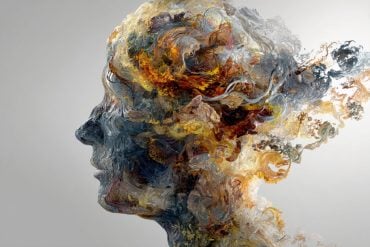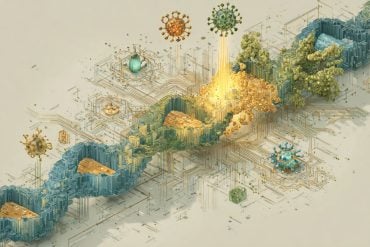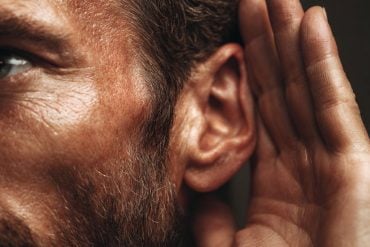Summary: A new study challenges the Myonuclear Domain Hypothesis of muscle memory. Researchers report nuclei gained during training persist even when muscle cells start to shrink as a result of disuse.
Source: Frontiers.
The old adage “use it or lose it” tells us: if you stop using your muscles, they’ll shrink. Until recently, scientists thought this meant that nuclei — the cell control centers that build and maintain muscle fibers — are also lost to sloth.
But according to a review published in Frontiers in Physiology, modern lab techniques now allow us to see that nuclei gained during training persist even when muscle cells shrink due to disuse or start to break down. These residual ‘myonuclei’ allow more and faster growth when muscles are retrained — suggesting that we can “bank” muscle growth potential in our teens to prevent frailty in old age. It also suggests that athletes who cheat and grow their muscles with steroids may go undetected.
Our biggest cells are in our muscles, and they’re all fused together
Syncytium. Sounds like a neo-noir comic book series. It’s actually a special type of tissue in your body, where cells are fused together extra close — so close, that they behave a like a giant single cell.
“Heart, bone and even placenta are built on these networks of cells,” says Lawrence Schwartz, Professor of Biology at the University of Massachusetts. “But by far our biggest cells — and biggest syncytia — are our muscles.” Like the Sin City series, it appeared at first that everything was black and white with syncytia.
“Muscle growth is accompanied by the addition of new nuclei from stem cells to help meet the enhanced synthetic demands of larger muscle cells,” explains Schwartz. “This led to the assumption that a given nucleus controls a defined volume of cytoplasm — so that when a muscle shrinks or ‘atrophies’ due to disuse or disease, the number of myonuclei decreases.”
A muscle can gain nuclei, but never loses them
This assumption long seemed valid, with many researchers reporting the presence of disintegrating nuclei in muscle tissue during atrophy induced by inactivity, injury or paralysis. But modern cell-type-specific dyes and genetic markers have shown that the dying nuclei other researchers had detected were in fact inflammatory and other cells recruited to atrophic muscle.
The new evidence paints a very different picture of muscle syncytium.
“Two independent studies — one in rodents and the other in insects — have demonstrated that nuclei are not lost from atrophying muscle fibers, and even remain after muscle death has been initiated.”
This suggest that once a nucleus has been acquired by a muscle fiber, it belongs to the muscle syncytium — probably for life. But Schwartz, for one, is unsurprised by the new findings.
“Muscles get damaged during extreme exercise, and often have to weather changes in food availability and other environmental factors that lead to atrophy. They wouldn’t last very long giving up their nuclei in response to every one of these insults.”
“Use it or lose it — until you use it again”
Since myonuclei are the synthetic engine of muscle fibers, retaining them should enable muscle size and strength to recover more quickly after one of these insults, and help to explain the phenomenon of ‘muscle memory’.
“It is well documented in the field of exercise physiology that it is far easier to reacquire a certain level of muscle fitness through exercise than it was to achieve it the first place, even if there has been a long intervening period of detraining. In other word, the phrase “use it or lose it” is might be more accurately articulated as ‘use it or lose it, until you work at it again’.”

As such, the findings have important implications beyond understanding muscle biology.
“Informing public health policy, the discovery that myonuclei are retained indefinitely emphasizes the importance of exercise in early life. During adolescence muscle growth is enhanced by hormones, nutrition and a robust pool of stem cells, making it an ideal period for individuals to “bank” myonuclei that could be drawn upon to remain active in old age.”
The findings also support frequent drugs testing for competitive athletes, with permanent bans for proven steroid cheats since they will benefit from the steroids long after their use has ended.
“Anabolic steroids produce a permanent increase in users’ capacity for muscle development. In keeping with this, studies show that mice given testosterone acquire new myonuclei that persist long after the steroid use ends.”
Source: Frontiers
Publisher: Organized by NeuroscienceNews.com.
Image Source: NeuroscienceNews.com image is adapted from Bruusgaard et al., 2010 in PNAS/ Frontiers in Physiology.
Original Research: Open access research for “Skeletal Muscles Do Not Undergo Apoptosis During Either Atrophy or Programmed Cell Death-Revisiting the Myonuclear Domain Hypothesis” by Lawrence M. Schwartz in Frontiers in Physiology. Published January 25 2019.
doi:10.3389/fphys.2018.01887
[cbtabs][cbtab title=”MLA”]Frontiers”Muscle Memory Discovery Ends ‘Use It or Lose It’ Dogma.” NeuroscienceNews. NeuroscienceNews, 25 January 2019.
<https://neurosciencenews.com/muscle-memory-dogma-10637/>.[/cbtab][cbtab title=”APA”]Frontiers(2019, January 25). Muscle Memory Discovery Ends ‘Use It or Lose It’ Dogma. NeuroscienceNews. Retrieved January 25, 2019 from https://neurosciencenews.com/muscle-memory-dogma-10637/[/cbtab][cbtab title=”Chicago”]Frontiers”Muscle Memory Discovery Ends ‘Use It or Lose It’ Dogma.” https://neurosciencenews.com/muscle-memory-dogma-10637/ (accessed January 25, 2019).[/cbtab][/cbtabs]
Abstract
Skeletal Muscles Do Not Undergo Apoptosis During Either Atrophy or Programmed Cell Death-Revisiting the Myonuclear Domain Hypothesis
Skeletal muscles are the largest cells in the body and are one of the few syncytial ones. There is a longstanding belief that a given nucleus controls a defined volume of cytoplasm, so when a muscle grows (hypertrophy) or shrinks (atrophy), the number of myonuclei change accordingly. This phenomenon is known as the “myonuclear domain hypothesis.” There is a general agreement that hypertrophy is accompanied by the addition of new nuclei from stem cells to help the muscles meet the enhanced synthetic demands of a larger cell. However, there is a considerable controversy regarding the fate of pre-existing nuclei during atrophy. Many researchers have reported that atrophy is accompanied by the dramatic loss of myonuclei via apoptosis. However, since there are many different non-muscle cell populations that reside within the tissue, these experiments cannot easily distinguish true myonuclei from those of neighboring mononuclear cells. Recently, two independent models, one from rodents and the other from insects, have demonstrated that nuclei are not lost from skeletal muscle fibers when they undergo either atrophy or programmed cell death. These and other data argue against the current interpretation of the myonuclear domain hypothesis and suggest that once a nucleus has been acquired by a muscle fiber it persists.







